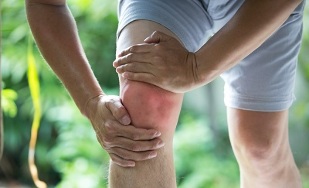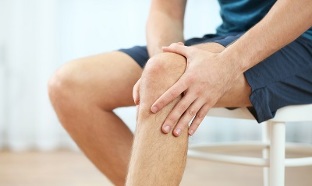
Knee osteoarthritis, or osteoarthritis of the knee, mainly affects women, usually after the age of 40. At an earlier age, such a pathology can develop due to injuries or professional sports. A particularly severe course of the disease is observed in people who are overweight or have varicose veins of the lower extremities.
The onset of the disease is characterized by the appearance of moderate pain in the knee during movement, especially when walking on stairs. There may also be pain when a person stands for a very long time or gets up after a long stay in a sitting position. The pain usually subsides at rest. Sharp and intense pain in osteoarthritis of the knee joint does not occur spontaneously, but is usually accompanied by long-term discomfort when walking and physical activity. It is the gradually increasing pain that is one of the main signs of osteoarthritis of the knee.
Disease stages
First stage
In the initial stages of the development of osteoarthritis of the knee, the bones in the knee do not change shape, only swelling of the joint can occur, which is usually associated with the accumulation of fluid in the knee. When the amount exceeds the allowable value, edema develops, affecting the back of the leg. In this case, you can relieve the swelling with the help of anti-inflammatory drugs.
Second stage
The next stage of knee osteoarthritis is characterized by a significant increase in pain intensity. The pain is noticeable even after a light load, a crunch occurs in the knee joint, which increases as the disease progresses. The patient bends the leg with difficulty, there is severe pain, up to the utter impossibility of bending it at the knee. Even in the second stage of the disease, the joint begins to change its shape, which is clearly noticeable when palpating - the expansion and clogging of the joint bones can be felt. Synovitis manifests itself much more strongly at this stage - the appearance of swelling as a result of the accumulation of fluid.
Third level
The third stage of the disease is characterized by the appearance of intense pain, which occurs even at rest. The patient searches for a long time for a suitable position in which the pain will decrease. With a circulatory disorder, pain can disturb a person even during sleep and cause a painful feeling in the joint. The mobility of the joint is minimized, the person often cannot keep the leg in a straight position and has to bend it when walking. If the bones are clearly deformed, the gait waddles and a change in shape of the lower extremities becomes noticeable.
How do you recognize osteoarthritis of the knee joint?

The patient is first referred for a blood test, followed by an X-ray, magnetic resonance tomography or computed tomography.
In some cases, ultrasound or arthroscopy (examination of the joint with a special device through a small incision) may be prescribed.
During the X-ray examination, the stage of development of the disease is determined, the picture shows changes in the joint and in the bones, as well as the distance between the bones. At an early stage of the disease, changes in the cartilage tissue are not visible on an x-ray.
With ultrasound, like computed tomography, you can identify abnormalities in soft joint tissue and determine the amount of fluid that has accumulated during the development of synovitis.
How is knee osteoarthritis treated?
Osteoarthritis of the knee is treated by specialists such as a rheumatologist or an orthopedic surgeon. At an early stage, in most cases, the disease is curable without surgery, but treatment must necessarily be comprehensive and qualified. In the second and third stages, it is impossible to return the joint to its previous shape without surgery. It is only possible to improve the condition of the periarticular tissue.
Nonsteroidal anti-inflammatory drugs are widely used to reduce inflammation and pain associated with osteoarthritis of the knee joint. After reducing the pain syndrome, the patient can be prescribed massage, therapeutic exercises and physiotherapy procedures.
For the treatment of osteoarthritis of the knee, drugs are also used that belong to the group of chondroprotectors and allow the restoration of cartilage tissue. Such preparations also help maintain the elasticity of the cartilage and the saturation of its tissues with moisture. In the first and second stages, chondroprotectors act gradually, treatment is quite long and can even last a year or a year and a half. Taking glucosamine and chondroitin sulfate at the same time has a greater effect. In the third stage, such drugs can no longer have a positive effect.
Drugs that dilate blood vessels have a good effect in the treatment of arthritis. They can improve blood flow to the joint and relieve cramps in small vessels, thereby restoring the affected joint. It is recommended to combine the use of such drugs with the use of chondroprotectors. To relieve painful muscle spasms, the patient may be prescribed muscle relaxants. Such drugs are used only in combination with chondroprotectors and joint traction. A compress made from Dimexide also has a beneficial effect on the treatment of osteoarthritis, which reduces inflammation and relieves pain, especially when fluid builds up. To make such a compress, you should mix a tablespoon of boiled water with a tablespoon of Dimexide. Then moisten a medical bandage in the resulting solution, place it on the affected joint and cover it with a plastic bag and diaper. The duration of the procedure is twenty to sixty minutes, once a day, no more, two to three weeks.
All drugs are used strictly as prescribed by a doctor without any contraindications. Osteoarthritis of the knee joint requires medication, physical therapy, and therapeutic exercises.



























